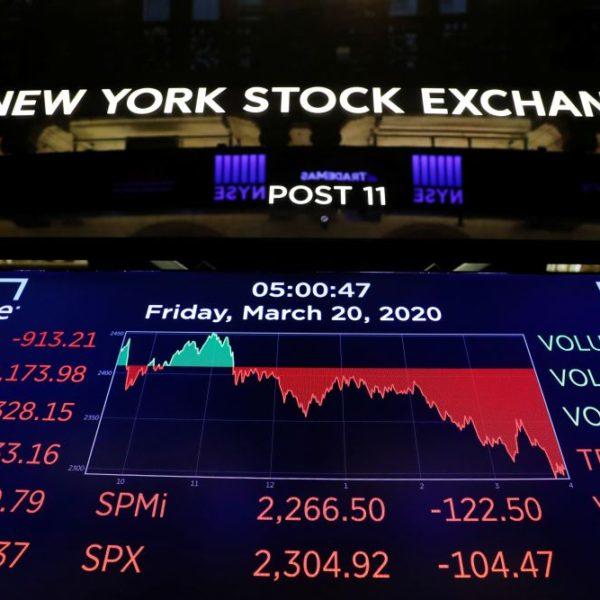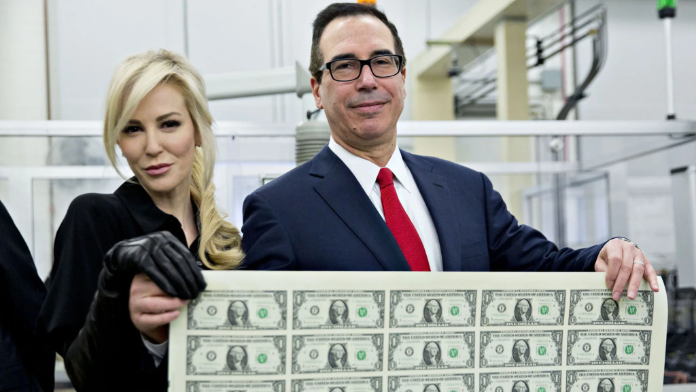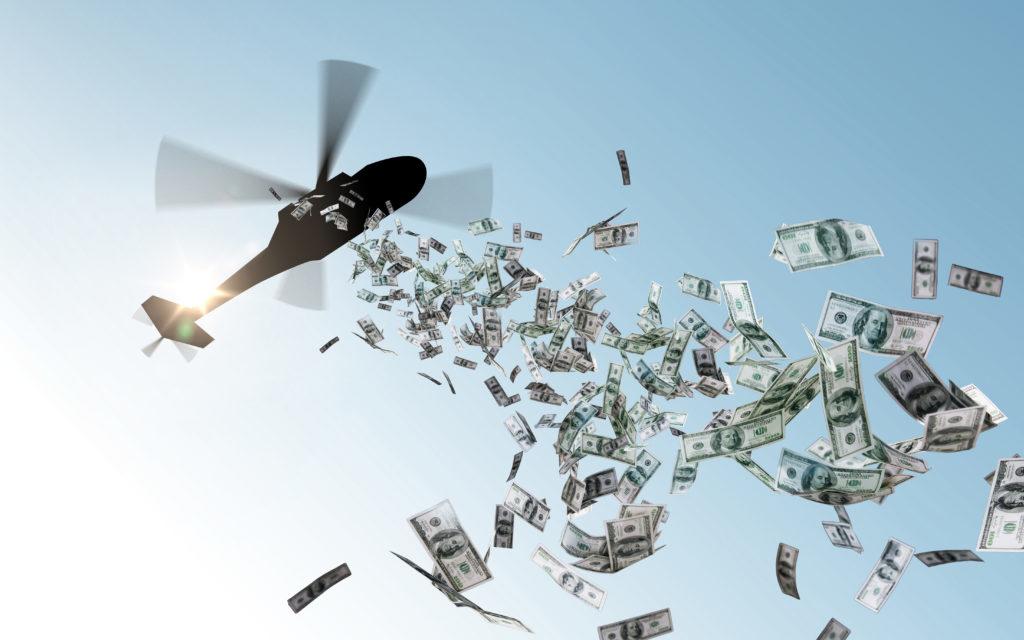‘Helicopter Money’: This Is The True Geopolitical Game-Changer
Authored by Alastair Crooke via The Strategic Culture Foundation,
As the US and the UK, to stem Covid-19 infections, adopt a close-to-wartime approach, with intrusive levels of intervention into social life, these governments – as the corollary to lockdown – are proposing massive bail-outs. At first brush, this may seem both sensible and appropriate. But wait. Bailing out what? Well, financial markets of course, but then… just about everything: Boeing, the US Shale-oil industry, airlines, the tourist industry, and (in the US) every citizen – through posting them a $1,000, or a $2,000 check, this week – or, as is mooted in DC – perhaps one every month. Great! Just like Christmas.
The markets crashed: $½ Trillion in ‘liquidity’ here; $1.5 Tn there – and there – and there. An alphabet soup of lending facilities — pretty soon you are talking ‘real money’. The alphabet soup cloaks the collective size of liquidity available to banks. And likewise for individuals? 210 million US adults X $1,000, X 12 or 18 (months), is a staggering sum of money — closer to $4 Tn, or 18% of US GDP. Likewise, UK Chancellor Rishi Sunak pledged £330bn, or 15% of GDP, to support the economy, on top of a three-month mortgage payment holiday and a slew of tax deferments, and to do, as well, “whatever it takes”.
So, how come? How is this money suddenly available – when we have repeatedly been told in the wake of the 2008 crisis that austerity must be the only answer? Well, welcome to the ‘new orthodoxy’ (actually it is not new at all: France tried it in the eighteenth century when it ‘printed’ the Assignats). Call it ‘helicopter money’, or, the so-called ‘Modern Monetary Theory’: The principle is that it is okay to print money – if governments don’t otherwise have it. The point here is that ‘helicopter money’ (money conjured out of nothing: empty units reflecting no underlying real economic value) is a paradigm change. A major paradigm change.
It is the legacy from 2008. That was primarily a banking crisis: Printing money seemed to work out pretty well then, in the view of the élites. The main reason that those ‘experts’ have thought that printing money worked in the wake of 2008 was because the Central Banks were able to reflate the financialised asset bubbles.
“But that wasn’t success, that was failure”, financial guru, Peter Schiff comments. It was a failure because it resulted in even bigger bubbles, and even greater debt – which precisely has set us all up for today’s crisis: For we are going into this crisis naked of any real tools to deal with supply-shock.
In 2008, everybody believed the money ‘printing’ was temporary: Bank balance sheets were all gummed up; and the Fed was going to be able afterwards to normalize interest rates, and shrink its balance sheet. Well, nobody is going to believe that, this time. No, debts will soar – and will be ‘forever’ debts.
Yet for today’s policy-makers, it all seems so reasonable, so plausible: If the Fed floods the financial system with money, interest rates can stay at zero for ever. What’s not to like about this? Certainly, it fits with Trump’s real estate career, built on low interest, easy debt. Governments now may borrow for a hundred years at zero interest; and banks can lend like fury, as the Fed has dropped the requirement for banks to keep any reserves against their loans (i.e. to ‘print’ more easy credit for the favoured).
Better still, governments can just conjure the money out of thin air (by monetizing its debts): It can use these funds to bail out all those businesses and citizens adversely affected by Covid-19, and become heroes. Welcome to the new ‘Orthodoxy’.
What’s the alternative? Well that’s the point. The financialized, monetarist worldview dogmatically pursued through the last decades has left the toolbox with only one tool (more money, more liquidity). They have driven the world into this monetarist cul-de-sac. They will go on doing the same thing (liquidity and bailouts), over and over again, and (per Albert Einstein), always hoping for a different and better result. But it won’t work. It won’t work because the problem is not lack of liquidity. It is that businesses have no business to do – under infection lockdown. We had better understand the consequences to this insanity. That’s all.
This time, the 2008 recipé will not work. The US is going to be hit hard. And Americans are only just waking up to this fact.
This New Orthodoxy is no more than a desperate throw of the dice to keep the western hyper-financialized system aloft. The ‘mobilized-for-war’ narrative is an attempt to justify authoritarian measures, and the false bail-out meme: There was no ‘free money’ during the Wars.
In the 2008/9 crisis, the public was bemused: The financial world seemed too arcane to grasp fully. Only later, was it appreciated that the banks were being saved by ‘socialising’ their mistakes and losses. These – the losses – were ‘socialised’ i.e. transferred to the public balance sheet, and the public were told to expect austerity – and pared down health and welfare systems, to pay for all these 2008 bail outs.
This time, it is not the banks, but corporations and their ‘junk’ debt, that the Authorities are hoping to preserve in aspic (just as the banks were, earlier). In simple terms, it will allow over-leveraged companies to go into even deeper debt – with those loans now backed by the US Federal government.
But, will a better informed public so readily agree that Boeing deserves a $60 Bn bailout, when all its cash was spent in the last years in buying back its own stock and paying large dividends. It may be argued that if the money simply is printed, austerity cuts may not be required. But printing money dilutes the underlying purchasing potential of the money that had existed before dilution. That is to say, it is the 60% who ultimately will pay the cost – again. The new austerity will be a covert wealth transfer through dilution of peoples’ purchasing potential.
As Schiff notes, monetary inflation “is probably not just the worst-case scenario, it’s probably the most likely scenario… the laws of economics apply here just like they did in the Weimar Republic of Germany, or in Zimbabwe, or in Venezuela. If we pursue the same monetary and fiscal policy they did, we’re going to receive the same monetary outcome they did (hyperinflation)”.
This all may seem a somewhat rarefied argument to some, but the implications (both political and geo-political) are huge. This wartime economic approach – of itself – is not going to bring radical change to our neo-liberalized institutional world, nor reform it. That window was shut after 2008. The reality today is that to ‘touch’ the system now might induce a debt-deflation – a prospect which truly terrifies the Establishment – on top of impending supply-shock recession.
We are locked in through the errors of the Central Bankers: No wonder the Authorities are trying to kindle a war atmosphere in order to say that ‘helicopter money’ is okay. “It’s wartime”. And they will probably order the military out on the streets soon. Saying what is written here, will soon be held to be ‘enemy propaganda’.
The effect of a war-like command economy will not be to sweep society or the economy onto a new course, but rather, will be to re-situate it into the old grooves. Will anyone believe that in this new ‘command economy’ era, the government directed bailouts and the credit lines, will not be channelled principally to the political élites and their allies?
Yet, just as after the sacrifices of two World Wars, there was ‘New Deal’ mood apparent amongst the people. So it was too, in the wake of 2008: There were calls for reform to a system that entrenched the richest one per cent; but instead we got austerity, and a return to business as usual. Policy was deliberately designed to prop up the old system, and make it function as before. Reform denied.
Today, people are fully focused on managing their lives under virus lockdown, but the political pendulum has been swinging markedly (so-called populist politics) against what is widely perceived as a politically and economically ‘rigged system’.
The question then is, firstly, will US monetary actions succeed? Will they succeed in saving the financial system, ‘as it used to be’? Well, take the call for helicopter money: the term refers to giving money directly to individuals as if dropping cash on everybody out of a helicopter. But Schiff points out, that when Milton Friedman (the father of monetarist economics) coined the term, he intended it as a joke:
“He was using it as an example of what not to do – about why Keynesian monetary stimulus doesn’t work. He said it’s a crazy, stupid idea … Because dropping money from helicopters doesn’t do anything. It’s just inflation. It just makes prices go up”.
And, secondly, will this approach – which anyway is not working, as markets continue to implode – provoke a more concerted opposition to financial excess and inequality, in all its various forms? Will the demand for reform of the neo-liberal system become unstoppable? Maybe the ‘community spirit’ of suffering the virus together, will not be so tolerant of leaders who have failed to take appropriate steps to staunch infection spread, in a timely fashion?
Here, it is the ‘war’ on Covid-19 – rather than the other ‘war’ to save the economy – that will play a key role in shaping the geo-political future. Enough people have already commentated on the communal, national sentiment being generated by Corona virus. Here in Italy, Italians do feel far more linked empathetically – as if fighting a common enemy (which in a way they are). We all feel for the inhabitants of Lombardy and Bergamo. And, Italians know too, that they are on their own.
This feeling of Euro sauve qui peut (every country to its own) is palpable, and not confined to those just outside the EU borders, such as when the Serbian President (reacting bitterly to news that the EU had imposed an export ban on equipment such as masks and gowns to protect medical workers), said: “International solidarity does not exist. European solidarity does not exist”, to which most Italians would have responded ‘hear, hear’. The only help for Italy arrived from China.
It is the return of the nation-state. Covid-19 will change the course of Italian politics, as well as determine – in a significant way – the future of the EU. Let us be clear: The US and the UK can only make those offers of gushing liquidity and bail-outs – because they ‘print’ money. They control their own money-supply, their deficits – and to a much lesser extent, have some scope over interest rates. EU states do not. And arguments over EU financial mitigation for Covid-19 will ‘rack’ EU institutions and unity – perhaps to breaking-point.
And this more general attitude of sauve qui peut and lack of empathy is probably felt nowhere more deeply than in China. The more so, even than Italy. China has been denigrated, particularly in America, in a way that many Chinese feel borders on racism. Pepe Escobar has written:
“Among the myriad, earth-shattering geopolitical effects of coronavirus, one is already graphically evident. China has re-positioned itself. For the first time since the start of Deng Xiaoping’s reforms in 1978, Beijing openly regards the US as a threat, as stated a month ago by Foreign Minister Wang Yi at the Munich Security Conference during the peak of the fight against coronavirus.
“Beijing is carefully, incrementally shaping the narrative that, from the beginning of the coronovirus attack, the leadership knew it was under a hybrid war attack. Xi’s terminology is a major clue. He said, on the record, that this was war. And, as a counter-attack, a “people’s war” had to be launched.”
Europe and America will be facing a very different Chinese-Russian axis in the wake of the Coronavirus. The gloves are off. And Europe will be the first to feel the effect: No more Euro prevarication. That is to say, no more ‘one foot in; one foot out’ in relations with China (on Huawei 5G – as just one example).
Russia and China well understand: Helicopter money, and unparalleled ‘printed’ bail-outs, this is the game-changer. For now, the US dollar is soaring on demand from states who see their own currencies crashing, but who have borrowed in dollars – and see those dollar loans becoming shockingly more costly, day-by-day.
But, the G7 Central Banks finally will have to fight the inflation monster that will be unleashed by their ‘helicopter theories’. Confidence in the dollar will decline, as more and more dollar helicopter ‘drops’ are made. Interest rates will rise, and western junk debt will become toxic, and untenable at higher rates.
In a word, the world will come to see the US as much less powerful and less competent than appearances have projected it. Its lacunae will stare out.
Is the time approaching for that global monetary re-set, as the dollar loses its shine, President Putin must be mulling…?
Tyler Durden
Tue, 03/24/2020 – 16:45


